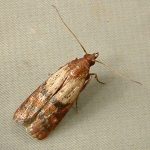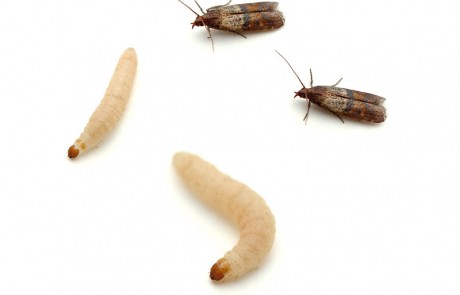Votre panier est actuellement vide !

The Indian meal moth
The Indian meal moth should not be confused with the moth.Its body is about 10 mm long and the wingspan is about 16 mm.Its wings are covered with « powder » (scales).When not active, the moth places its four wings so that only two can be seen.These visible wings appear to have a large pale band across them, while their tips are a contrasting russet brown.The larvae have a black head and the rest of the body cream and measure about 2 cm long at the tip. These visible wings appear to have a large pale band across them, while the tips are a contrasting russet brown.The larvae have a black head and cream-colored body and are about 2 cm long at the end of the last instar.
Latin Name: Plodia interpunctella
Description:The Indian meal moth should not be confused with the moth.Its body measures about 10 mm and the wings are about 16 mm in span.Its wings are covered with « powder » (scales).When not active, the moth places its four wings so that only two can be seen.These visible wings appear to be crossed by a large pale band, while their tips display a contrasting reddish brown. The larvae have a black head and cream-colored body and are about 2 cm long at the end of the last instar.
Reproduction: The female usually begins laying eggs 3 days after emergence.She lays 200-400 eggs on or near the food products she has infested. The larval stage lasts about 40 days, but can last up to a year under unfavorable conditions. The caterpillar feeds on food products while leaving a silken thread behind. Some caterpillars will even go into diapause, a kind of torpor that allows them to wait for more favorable conditions and makes them more resistant to treatments. When the caterpillar is ready to pupate, it weaves a cocoon on the surface of infested products or in adjacent cracks and crevices. The moth does not emerge until one to four weeks later. When temperature conditions are favorable and food is abundant, there can be 4 and even 5 generations per year.
Habits: Several food products are the target of the Indian meal moth:flour, wheat, bran, dehydrated fruits, nuts, dried chili peppers,seed seeds, chocolate, milk powder, cookies etc. It occasionally consumes dried plant and animal substances such as insect collections, museum specimens, bird seed, dried grasses and pet food. Larvae have even been known to stick to fresh apples and pears in a warehouse, often laying their eggs on corrugated cardboard. They often lay their eggs on corrugated cardboard. The damage is caused by caterpillars. The infested food is entangled with silk threads and sheaths containing the excrement of the larvae.The moths are seen flying in dark places, but they hide from the light.
Prevention:Examine all food and packages brought home to ensure they are free of pests.Make sure purchased foods are fresh.Buy grain products in small quantities, especially in the summer.Keep excess food in airtight containers to prevent the insects present from spreading to other foods.Don’t prolong food storage for too long periods. When moths are present, the first step is to determine the source of the infestation and remove all contaminated food. You may be tempted to put the infested food in a garbage bag and quickly remove it from your home for disposal. However, it is better to expose them to extreme temperatures by freezing them for a few days or baking them in the oven to make sure that the insects do not get into the environment again. Sometimes the problem will be solved after this step, but you will have to be even more vigilant in the coming days and weeks in case the infestation is not controlled. In some cases, food that was only lightly infested can be preserved if exposed to these extremes of temperature. In other cases, this is not advisable because the presence of the insects in the food would encourage the production of dangerous toxins, produced by microscopic fungi, that would not be destroyed by heat. It is important to check all stored products. A good cleaning of the infested areas is necessary. All the cocoons found attached to the shelves, walls or ceiling must be eliminated. Cracks and joints are particularly important to watch out for. The elimination of infested products and a good cleaning are often enough to solve the problem. Finally, treatments can be applied in the home but should be administered by specialists to ensure that all sources of infestation are treated.
